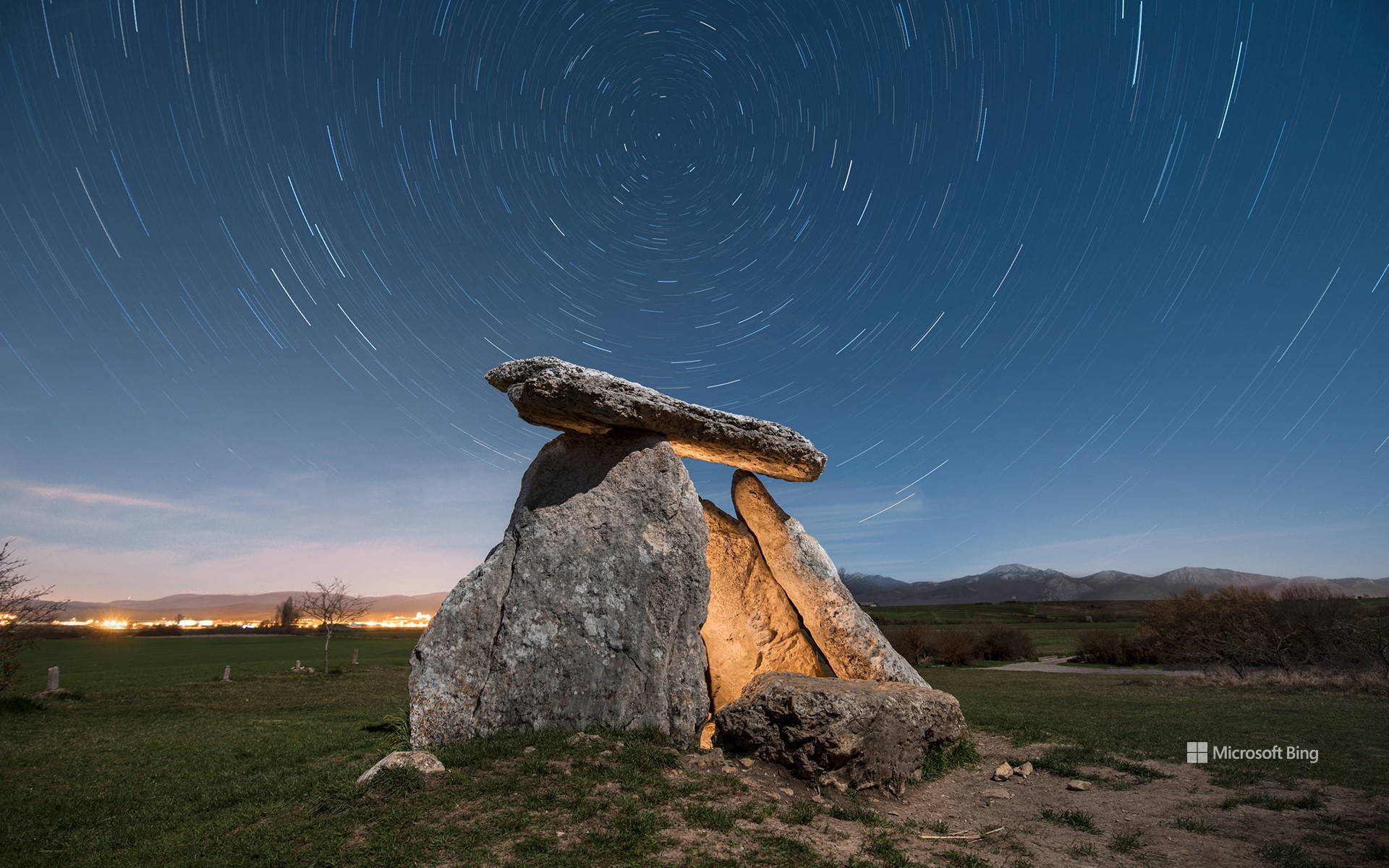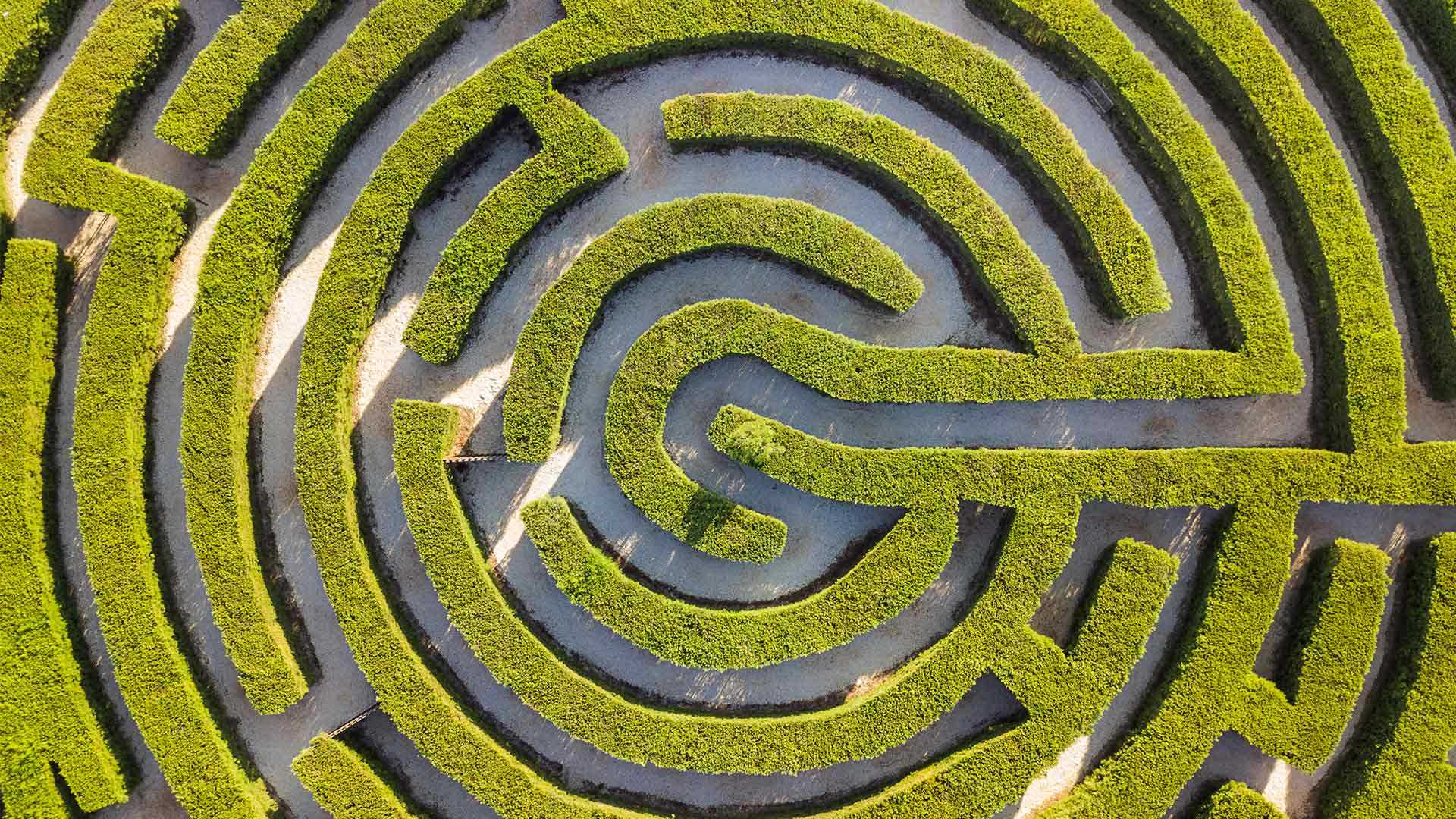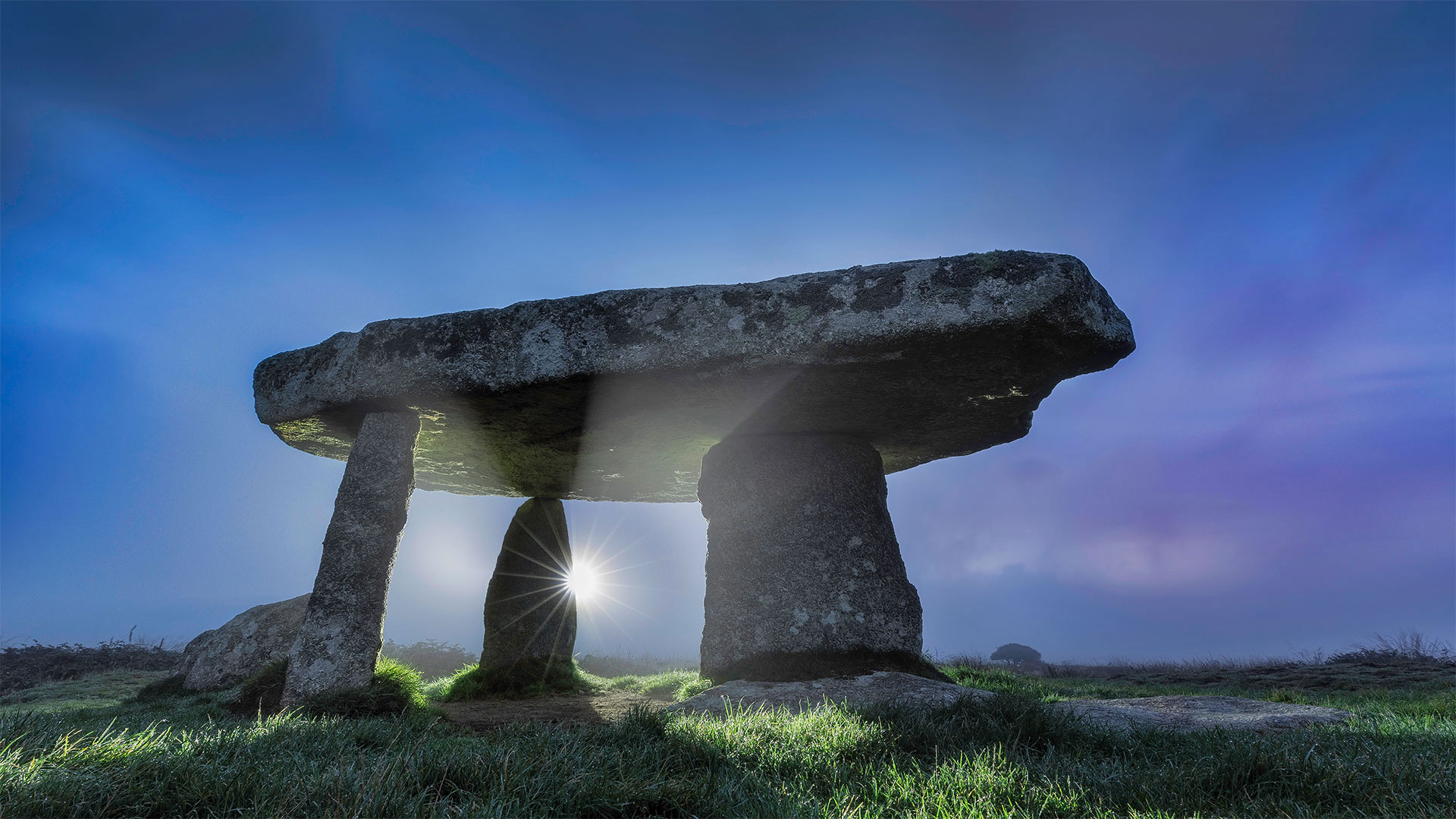索尔吉奈特克斯的巨石墓,巴斯克地区,阿拉瓦省,西班牙 Dolmen of Sorginetxe, Basque Country, Álava, Spain (© David Herraez Calzada/plainpicture)

索尔吉奈特克斯的巨石墓,巴斯克地区,阿拉瓦省,西班牙 Dolmen of Sorginetxe, Basque Country, Álava, Spain (© David Herraez Calzada/plainpicture)
天空中的圆周率 Pi in the sky
庆祝圆周率日
计算圆的周长与直径的比值就像 π 一样简单。今天是圆周率日,一个专门庆祝这一数学常数的节日。这个日期之所以被选中,是因为3、1、4正是圆周率π的前三位有效数字。作为一个无理数,圆周率无法被写成分数,其小数部分会无限延伸且不重复。人类对 π 的探索可以追溯到公元前 1900 年左右的古巴比伦和古埃及。
然而,圆周率日的正式起源相对较晚。20 世纪 80 年代,物理学家拉里·肖在旧金山一家科学博物馆组织了首次圆周率日的庆祝活动。当天,工作人员围着圆圈行走,品尝与 π(Pi)谐音的馅饼(Pie),以此象征这一数学常数。今日图片带我们来到西班牙北部的阿拉瓦,星空在索尔吉奈特克斯的巨石墓上空旋转划出圆形轨迹。这座史前巨石遗迹可追溯至公元前 3000 年。自古以来,圆周率(π)在天文学研究中扮演着重要角色,印度和波斯的天文学家曾计算出最早且最精确的圆周率近似值,为人类探索宇宙奠定了基础。
Celebrating Pi Day
Calculating the ratio of a circle's circumference to its diameter is as easy as pi. Today is Pi Day, an event that celebrates this mathematical constant. This date was chosen because 3, 1, and 4 are the first three significant figures of pi (π) when it is written out. Pi is an irrational number, which means that it can't be written as a fraction. When written out, its decimal representation goes on infinitely without repeating. The oldest attempts to calculate pi date back to ancient Babylon and Egypt, around 1900 BCE.
Pi Day, however, has more recent origins. In the 1980s, physicist Larry Shaw organized the first celebration, where staff at a San Francisco science museum walked around in circles and then ate the number's delicious homophones: pies. Today's image takes us to Álava, northern Spain. The circular motion of the stars appears above the Dolmen of Sorginetxe, an ancient megalithic monument dating back to 3000 BCE. Pi has long played a key role in the study of the stars, and some of the most accurate early approximations of the number were calculated by Indian and Persian astronomers.
Wat Phra Ngam,大城府历史公园,泰国 Wat Phra Ngam, Ayutthaya Historical Park, Thailand (© boonchai wedmakawand/Alamy Stock Photo)

Wat Phra Ngam,大城府历史公园,泰国 Wat Phra Ngam, Ayutthaya Historical Park, Thailand (© boonchai wedmakawand/Alamy Stock Photo)
一个π A piece of pi
圆周率日快乐!
有人这样说过,世界上唯一不变的是变化。然而,在数学里却有许多固定不变的常数,今天,我们要庆祝的也许是其中最著名的一个:π。圆周率是圆的周长与直径之比,约为3.14159。每年的3月14日,全世界的数学爱好者都会用烘焙来庆祝圆周率π日——这既是对数学常数π的庆祝,也是对其同音字,美味的“派”的庆祝。它始于1988年,当时物理学家拉里·肖将日期(3/14)与这个常数的前三位数联系起来。今天,数学家和爱好者们用吃派和背诵π来庆祝圆周率日。你知道吗,当你的时钟敲响1:59时,表示你离圆周率的实际值又近了三位小数。圆周率无处不在,甚至在大自然中也是如此。图中是泰国大城府寺庙的一棵菩提树,其形状就像圆周率的符号。无论你是数学怪才,还是只是为了享受美食,每个人都可以享受“派”节!
Happy Pi Day!
They say the only constant in life is change. In mathematics, however, there are many constants and today, we're celebrating perhaps the most famous of them all: pi. Represented by the symbol π, this tasty-sounding number is the ratio of a circle's circumference to its diameter, approximately 3.14159. Every March 14, mathematics fans across the world get baking to mark Pi Day with a pie. It began in 1988, when physicist Larry Shaw connected the date (3/14) with the first three digits of π. Today, mathematicians and enthusiasts celebrate Pi Day with pie eating and pi reciting. Did you know that when your clock strikes 1:59 today, you will be three decimal places closer to the real value of pi? Pi is everywhere, even in nature. Pictured here is a bodhi tree which has grown over an arch into the shape of the pi symbol at Wat Phra Ngam, a temple in Ayutthaya, Thailand. Whether you're a math geek or just in it for the treats, Pi Day is for everyone to enjoy!
阿伊纳帕植物园灌木丛迷宫,塞浦路斯 Labyrinth in Cyherbia Botanical Park, Cyprus (© Tpopova/Getty Images)

阿伊纳帕植物园灌木丛迷宫,塞浦路斯 Labyrinth in Cyherbia Botanical Park, Cyprus (© Tpopova/Getty Images)
美丽的曲径迷宫 A beautiful labyrinth
圆周率日
今天,我们用这张绝美无比的灌木丛迷宫鸟瞰图来庆祝圆周率日,该迷宫位于塞浦路斯的阿伊纳帕植物园。圆周率日的意义在于纪念数学常数π。如果用计算器求圆周率的值,它可能会被截止到小数点后15位或更少,但在数学中π被认为是一个无限的比值。阿伊纳帕植物园灌木丛迷宫的圆形图案把圆周率公式带入了现实,这里也是长途步行爱好者的必游之地。如果你准备好迎接挑战,那就来这个巨型迷宫试试吧。
Pi Day
Today we're celebrating Pi Day with this magnificent bird's-eye image of the maze of bushes at Cyherbia Botanical Park in Ayia Napa, Cyprus. The significance of this day is to remember the mathematical constant Pi. If you use a calculator to find the value of Pi, it may truncate at 15 decimal digits or less, but in mathematics it is considered a never-ending ratio. The circular pattern of the labyrinth at the Cyherbia Botanical Park brings this equation to life and is a must-visit for people who love long walks. If you're ready for a challenge, give this large hedge maze a go.
兰洋夸特墓室,英国康沃尔郡 Lanyon Quoit burial chamber, Cornwall, England (© Guy Edwardes/Minden Pictures)

兰洋夸特墓室,英国康沃尔郡 Lanyon Quoit burial chamber, Cornwall, England (© Guy Edwardes/Minden Pictures)
天空中的圆周率...... It's just pi in the sky...
Pi Day
Did Neolithic humans build this structure to celebrate Pi Day? Not likely. Pi Day is a relatively recent phenomenon—invented by a physicist in 1988 and designated by Congress a national holiday in 2009. But it's already almost certainly the most popular holiday celebrating a mathematical constant. While Pi Day is a young tradition, the number π (pi) itself has been a fascination since antiquity, when it was first calculated as the ratio of a circle's circumference to its diameter.
You probably know that March 14 was chosen for Pi Day since the date expressed numerically (in month/date format) matches the number's first digits, 3.14. Aside from eating pie to celebrate, some people go to great lengths to memorize digits that go way beyond 3.141592…, which earns them bragging rights in some, um, circles. The world record is a staggering 70,000 digits after the decimal point—the remarkable feat was achieved by 21-year-old student Rajveer Meena in 2015.
Take a moment from your Pi Day revelry to appreciate the unintentional π symbol formed by this Neolithic burial chamber in Cornwall, England. As the morning sun warms Lanyon Quoit's ancient stones, it's impossible not to wonder who built it and how, since it predates metal tools and is older than Egypt's pyramids. Theories abound, of course, but could π have been involved?
圓周率日
新石器时代的人类建造这个建筑是为了庆祝圆周率日吗?不太可能。圆周率日是一个相对较新的现象,由物理学家在1988年发明,并在2009年被国会指定为全国性节日。但几乎可以肯定,这已经是庆祝数学常数最受欢迎的节日。虽然圆周率日是一个年轻的传统,但从远古时代开始,圆周率(Pi)本身就一直是一个令人着迷的数字,当时它最初被计算为圆的周长与直径之比。
你可能知道,3月14日被选为圆周率日,因为数字表示的日期(月/日格式)与数字的第一位数字3.14匹配。除了吃馅饼庆祝外,有些人会不遗余力地记住远远超过3.141592的数字,这让他们在一些圈子里大肆吹嘘。这项世界纪录在小数点后达到了令人震惊的70000位。这项了不起的壮举是由21岁的学生拉杰维尔·米娜在2015年创造的。
从你的π日狂欢中抽出一点时间,欣赏一下英格兰康沃尔新石器时代墓室无意中形成的π符号。当早晨的阳光温暖着拉尼恩·库伊特的古老石头时,我们不可能不去想它是谁建造的,是如何建造的,因为它比金属工具更早,比埃及的金字塔还要古老。当然,各种理论比比皆是,但π是否也会参与其中呢?